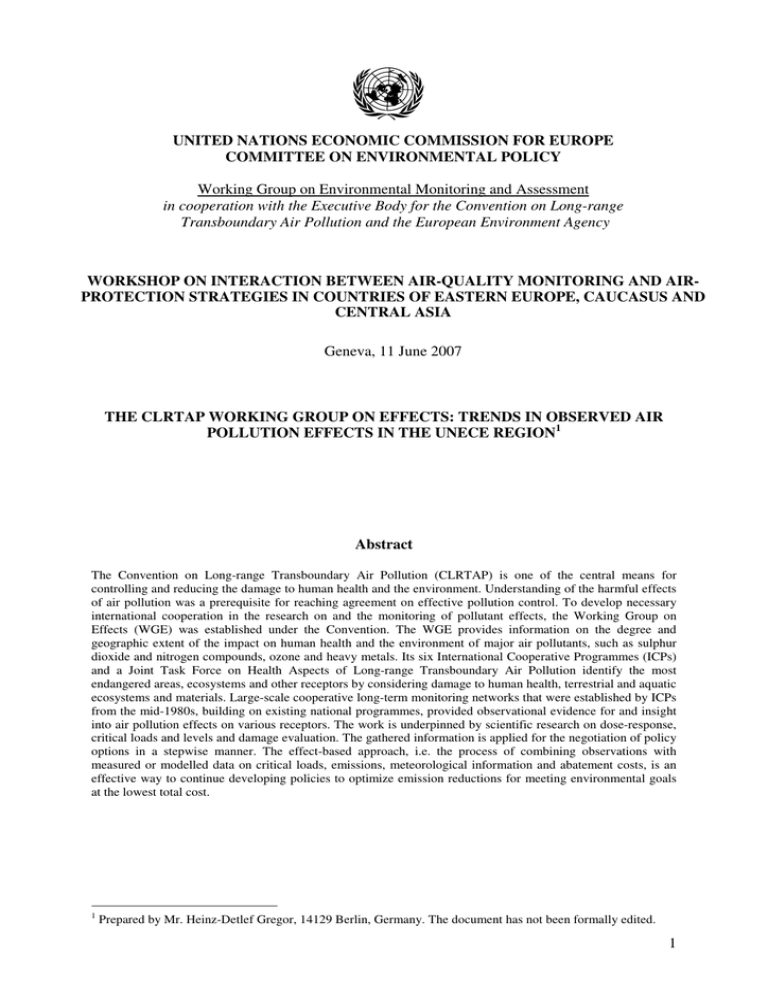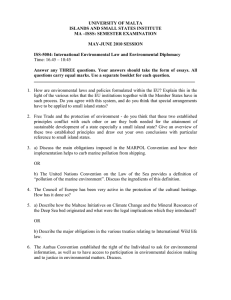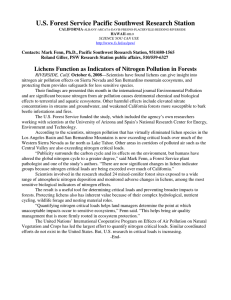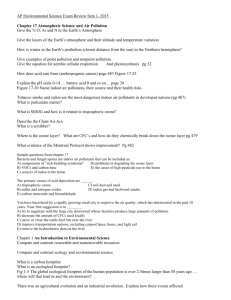1 UNITED NATIONS ECONOMIC COMMISSION FOR
advertisement

UNITED NATIONS ECONOMIC COMMISSION FOR EUROPE COMMITTEE ON ENVIRONMENTAL POLICY Working Group on Environmental Monitoring and Assessment in cooperation with the Executive Body for the Convention on Long-range Transboundary Air Pollution and the European Environment Agency WORKSHOP ON INTERACTION BETWEEN AIR-QUALITY MONITORING AND AIRPROTECTION STRATEGIES IN COUNTRIES OF EASTERN EUROPE, CAUCASUS AND CENTRAL ASIA Geneva, 11 June 2007 THE CLRTAP WORKING GROUP ON EFFECTS: TRENDS IN OBSERVED AIR POLLUTION EFFECTS IN THE UNECE REGION1 Abstract The Convention on Long-range Transboundary Air Pollution (CLRTAP) is one of the central means for controlling and reducing the damage to human health and the environment. Understanding of the harmful effects of air pollution was a prerequisite for reaching agreement on effective pollution control. To develop necessary international cooperation in the research on and the monitoring of pollutant effects, the Working Group on Effects (WGE) was established under the Convention. The WGE provides information on the degree and geographic extent of the impact on human health and the environment of major air pollutants, such as sulphur dioxide and nitrogen compounds, ozone and heavy metals. Its six International Cooperative Programmes (ICPs) and a Joint Task Force on Health Aspects of Long-range Transboundary Air Pollution identify the most endangered areas, ecosystems and other receptors by considering damage to human health, terrestrial and aquatic ecosystems and materials. Large-scale cooperative long-term monitoring networks that were established by ICPs from the mid-1980s, building on existing national programmes, provided observational evidence for and insight into air pollution effects on various receptors. The work is underpinned by scientific research on dose-response, critical loads and levels and damage evaluation. The gathered information is applied for the negotiation of policy options in a stepwise manner. The effect-based approach, i.e. the process of combining observations with measured or modelled data on critical loads, emissions, meteorological information and abatement costs, is an effective way to continue developing policies to optimize emission reductions for meeting environmental goals at the lowest total cost. 1 Prepared by Mr. Heinz-Detlef Gregor, 14129 Berlin, Germany. The document has not been formally edited. 1 1. Introduction The history leading to the Convention on Long-range Transboundary Air Pollution can be traced back to the 1960s. From that time the link between sulphur emissions in Europe and the acidification of lakes and forest ecosystems in Scandinavia became more and more established by scientists. The Convention was adopted in 1979 within the framework of the UN Economic Commission for Europe (ECE) and entered into force in 1983. It was the first multilateral treaty to protect the environment against the growing threat of acid precipitation and photochemical smog and evolved to be a major driving force for protecting man and his environment from the adverse effects of air pollution in its 27 years´ history. Taking an increasing spectrum of air pollutants into consideration (including nitrogen, sulphur, groundlevel ozone, particulate matter, heavy metals and persistent organic pollutants (POPs)), the Convention has been extended by eight specific protocols. The Convention is an institutional framework for collaborative research and exchange of information and for specific policy measures supported by atmospheric measurements and modelling, effects monitoring and integrated assessment. While effects of air pollution always were a major consideration in the development of protocols, the early protocols, as for example the 1985 Sulphur Protocol, did not use the knowledge on effects to define Parties’ obligations for emission reductions, but aimed at "flat rate" reductions. Only in the 1998 Protocol on Nitrogen Oxides effects were first used more directly by taking “internationally accepted critical loads” into account. The effects-based approach was again used for the 1999 Gothenburg Protocol, which simultaneously addresses acidification, eutrophication and ground-level ozone by setting emission ceilings for four pollutants: sulphur, nitrogen oxides, ammonia and volatile organic compounds. Since then the effects-based approach is seen as the most effective way to continue developing policies to optimize emission reductions for meeting environmental goals at the lowest costs (WGE 2004). 2 Figure 1: Organigramme of the Convention on Long-range Transboundary Air Pollution 2. Observations, trends and challenges The Working Group on Effects (WGE) was established in 1981. It performs long-term monitoring, demonstrates interrelationships between emissions and effects, provides information on the degree and geographic extent of impacts on human health and the environment and directs scientific research on dose-response functions, critical loads and levels and other elements for effects-based approaches. Today there are six International Cooperative Programmes (ICPs) reporting to the WGE and a Joint Task Force on the Health Aspects of Air Pollution (TF Health), between the World Health Organisation (WHO) and the Executive Body of the Convention (EB), that reports through the WGE (Figures 1 and 2). More information on the Convention including. the Protocols and the official documents of the WGE can be obtained from the website www.unece.org/env/lrtap. 3 Figure 2: Monitoring sites of three ICPs and the area covered by ICP Modelling and Mapping, all active under the Working Group on Effects Judging from the reported emission data and monitored depositions, the effects-based approach has been very successful throughout the ECE region! Pollutant input has remarkably decreased! But now the question is: are there trends or changes in ecosystem quality in response to the decreasing emissions in the ECE region? In fact, observations and trends reported by the ICPs include: • soils at many sites recover from high sulphur inputs in the past by releasing more sulphate than they currently receive; • there is a remarkable decrease in sulphate concentrations in lakes and streams and first signs of biological recovery have been observed; • exceedance of critical loads and their geographical extent are substantially less than in 1990 for acidity, but only slightly less for nutrient nitrogen; • nitrogen will continue to accumulate in terrestrial ecosystems moving them towards nitrogen saturation; • forest condition in Europe has been deteriorating for more than two decades due to synergistic effects of a range of natural and anthropogenic factors, nutrient imbalances increase the sensitivity to climate factors and susceptibility to parasite attacks. Several types of transboundary pollution will continue to cause threats to human health and the environment: 4 • the ozone AOT40 and critical fluxes of ozone remain exceeded in many places in Europe; • problems with acidification will not completely disappear due to nitrogen oxides and still high loads of ammonium; • the problem of eutrophication is not at all solved by now; • heavy metals are accumulating in soils and catchments due to long-range transport and other anthropogenic inputs; • particulate matter remains a serious problem causing loss in life expectancy. 3. Recent achievements of the effects-oriented activities The twenty-fifth session of the Working Group on Effects took place in Geneva from 30 August to 01 September 2006. The report of the meeting ECE/EB.AIR/WG.1/2006/2 as well as all other official documents delivered to it are available under www.unece.org/env/wge/documents.htm. Recent achievements of the effects-oriented activities are summarised in a Joint Report (ECE/EB.AIR/WG.1/2006/3 and ECE/EB.AIR/WG.1/2006/2 Add.1). The WGE welcomed the recent activities of the ICPs and their data centres, the TF Health and the Joint Expert Group on Dynamic Modelling (JEG) in addressing priority tasks that support effective implementation of the Convention, particularly the input to reviews of the three most recent protocols. It noted with appreciation the increased number of participation in the session and the increasing trend of Parties participating in the activities of the effect-oriented programmes. It invited the Executive Body to reiterate its invitation to Parties to nominate national focal centres for those effects-oriented activities in which they were not yet actively participating. Only a selection of major achievements of the ICPs and the TF Health, which were reported to the 25th session of the WGE, can be described here briefly. Detailed information can be obtained from the Joint Report and the technical reports ECE/EB.AIR/WG.1/2006/5 to ECE/EB.AIR/WG.1/2006/11, other official documents of the session and a series of scientific publications of the programmes. ICP Forests reported significant decreasing trends of sulphur deposition, but no or only weak trends of nitrogen deposition (Figure 3). There was a clear relationship between soil pH and ground vegetation and also the extent of nitrogen deposition was reflected in the composition of ground vegetation in forests. Application of dynamic models showed that the implementation of the obligations of the Gothenburg Protocol will lead to recovery of ecosystems from acidification in the next decades, but the original or pre-industrial pH will not be reached at all plots. A first application of the BERN biodiversity model demonstrated that changes in the C/N-ratio and base saturation of the soil due to atmospheric deposition would lead to vegetation changes. A forest health database is expected to be established in common responsibility of the EC and ICP Forests, to be operational by 2008. 5 Figure 3: Development of mean plot deposition of sulphate (S-S04), nitrate (N-NO3) and ammonium (N-NH4), from the ICP Forests Executive Report (2006) ICP Waters reported on the calculation of critical loads and target loads at monitoring sites and drew special attention to the temporal effects of sulphur adsorption and nitrogen retention on acidification. Nitrogen processes and fluxes in catchments continued to be major unknown factors despite extensive scientific research. In addition, climate change effects on catchments and freshwaters will add complexity in the evaluation of acid deposition scenarios. A “Workshop on confounding factors in recovery from acidification" is held in October 2006, in Bergen, Norway. ICP Materials presented Europe-wide maps of copper runoff from surfaces on buildings and constructions (1980 - 2005). Corrosion in general was decreasing 1987 - 1997 at the experimental sites, which in 1997 - 2003 continued for carbon steel, but not for zinc and limestone. The programme also presented corrosion maps in high spatial resolution in the Czech Republic and Germany . Results for carbon steel, zinc, bronze and copper were expressed as annual mass loss, while results for limestone are presented as mean annual surface recession. ICP Vegetation summarised recent results on the mappings of ozone critical level exceedances, carried out in collaboration with the EMEP MSC-West. The spatial gradient (North - South Europe) was large for the concentration-based approach (AOT40) in comparison to the flux based approach, in particular for forests. The effects of ozone on vegetation could be influenced by changes in climate, but also by interactions with nitrogen pollution. A “Workshop on critical levels of ozone” was held in 2005 in Obergurgl, Austria, results are reported in ECE/EB.AIR/WG.1/2006/11. The ICP further reported on trends in concentrations of heavy metals and nitrogen in European mosses. ICP Integrated Monitoring reported that sulphate concentrations in deposition and runoff and soil water were generally decreasing as a response to decreasing deposition. Nitrogen in deposition did not correlate with soil and runoff water. The reasons for mixed response of runoff and soil water lie in ecosystem processes. Budget calculations for heavy metals indicated considerable accumulation in catchments. Critical loads at the monitoring sites were exceeded for Pb and Hg, but not for Cd. 6 ICP Modelling and Mapping presented updated data from national focal centres on critical loads of acidification, eutrophication and heavy metals as well as on dynamic models for acidification. Exceedance maps have been produced in collaboration with the two regional centres of EMEP. The methodology of all mapping exercises is fully documented in the ICP´s Mapping Manual that has recently been made available in Russian translation. Taking assessments and recommendations from JEG into account, it was concluded that the use of critical loads of acidification and nutrient nitrogen as well as of dynamic models and target loads of acidifying pollution was possible in the review of the Gothenburg Protocol. Results of calculation of critical loads of heavy metals were delivered to a Task Force on Heavy Metals (acting under the Working Group on Strategies and Review, WGSR), which is performing technical work for the review of the 1998 Heavy Metals Protocol. A voluntary call for data that would update critical loads for eutrophication and parameters for related dynamic modelling is planned for autumn 2006 (not for use in the Gothenburg review). There is a report available on the “Workshop on causal relations of nitrogen in the cascade” (ECE/EB.AIR/WG.1/2006/15). The TF Health informed about health risks of ozone. The estimated rural concentration of ozone will remarkably decrease with implementation of the Gothenburg Protocol by 2020. There are global updates to the WHO Air Quality Guidelines on ozone and particulate matter. A report on “Health risks of particulate matter from long-range transboundary air pollution” was published in 2006. The risk assessment of lead, cadmium and mercury has been updated and results described in a draft report “Review of health risks of heavy metals from longrange transboundary air pollution”. Reporting on cross-cutting items of the effects-oriented activities addressed i. a. common tasks of all programmes such as • contributions on effect-based approaches for the Protocol reviews, • dose-response functions and stock at risk, • links between observations and critical thresholds, loads and levels. Contributions of the Programmes to these common items including scientific inputs to the Protocol reviews (as update to the 2004 Substantive Report, WGE 2004) are summarised in the 2006 Joint Report and in the report of the 25th WGE session. The WGE took note of the recent achievements, approved of the results of the 2005 call for data (acidification and eutrophication) by the Coordination Centre for Effects as well as the updates of the critical loads of heavy metals. It recommended that the results be used for work under the Convention. The WGE confirmed again that the methodology for calculating critical loads of heavy metals as described in the Modelling and Mapping Manual was scientifically sound and formed a satisfactory basis for the application of an effects-based approach as described in the report of the Task Force on Heavy Metals to the 38th session of the WGSR (EB.AIR/WG.5/2006/2, paragraph 75). The WGE also approved of the proposal from the CCE to issue a voluntary call for data for nitrogen-related parameters. It took note of the results of scientific workshops under the Convention. The WGE noted the overall importance of further work on POPs. 7 Conclusions From the observations by the ICPs` monitoring systems and networks, some of which are based on time series of more than 15 years, it can be concluded that threats related to acidification, eutrophication, ozone, heavy metals and persistent organic pollutants (POPs) will all be diminished as a result of the existing protocols being implemented: Critical load exceedances will be reduced, chemical recovery (from acidification) will be observed, it will be followed by biological recovery. Despite of such development, several problems will remain. While aquatic ecosystems need years or decades to recover, terrestrial ecosystems need decades to centuries. Monitoring and assessing effects of air pollutants together with other stresses, e.g. climate change, and integrating results in a systematic and comparable manner remain to be challenges to the effect-oriented work under the Convention. All 51 European and North American Parties to the Convention are urged to continue their support for the necessary environmental surveys. 4. References WGE (2004): Working Group on Effects: Review and assessment of air pollution effects and their recorded trends. Working Group on Effects, Convention on Long-range Transboundary Air Pollution. National Environmental Research Council, United Kingdom, 68 pp, ISBN I 870393 77 5 Matti Johansson, Heinz Gregor, Beat Achermann, Fred Conway, Régis Farret, Martin Forsius, Harry Harmens, Thomas Haußmann, Jean-Paul Hettelingh, Alan Jenkins, Tor Johannessen, Michal Krzyzanowski, Vladimir Kucera, Berit Kwaeven, Martin Lorenz, Lars Lundin, Wojciech Mill, Gina Mills, Maximilian Posch, Brit-L. Skjelvkvale, Till Spranger, Merete J.Ulstein, Keith Bull: Twentyfive years of effects research for the Convention on Long-range Transboundary Air Pollution. 7 pp, Proceedings IUAPPA 13th Clean Air Congress, London 2004. ICP Forests (2006): The Condition of Forests in Europe – 2006 Executive Report. Fed. Res. Ctre for Forestry and Forest Products, 36 pp, Hamburg, 2006 The documents quoted in the text are available from the Convention’s website in English, French and Russian. 8




